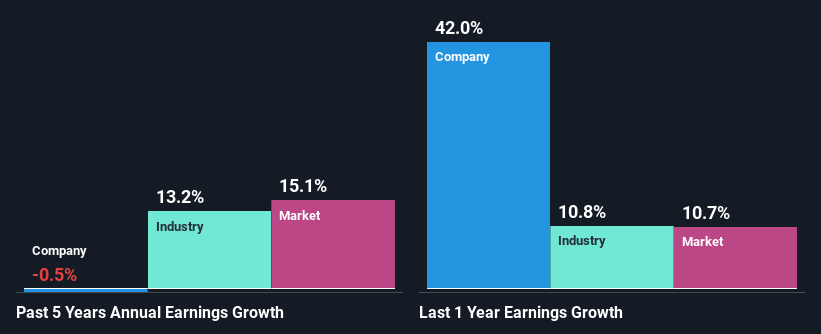Is Arcosa, Inc.'s (NYSE:ACA) Recent Price Movement Underpinned By Its Weak Fundamentals?
With its stock down 6.1% over the past week, it is easy to disregard Arcosa (NYSE:ACA). We, however decided to study the company's financials to determine if they have got anything to do with the price decline. Fundamentals usually dictate market outcomes so it makes sense to study the company's financials. Specifically, we decided to study Arcosa's ROE in this article.
ROE or return on equity is a useful tool to assess how effectively a company can generate returns on the investment it received from its shareholders. Put another way, it reveals the company's success at turning shareholder investments into profits.
Check out our latest analysis for Arcosa
How Do You Calculate Return On Equity?
Return on equity can be calculated by using the formula:
Return on Equity = Net Profit (from continuing operations) ÷ Shareholders' Equity
So, based on the above formula, the ROE for Arcosa is:
4.9% = US$100m ÷ US$2.0b (Based on the trailing twelve months to September 2022).
The 'return' refers to a company's earnings over the last year. Another way to think of that is that for every $1 worth of equity, the company was able to earn $0.05 in profit.
What Is The Relationship Between ROE And Earnings Growth?
So far, we've learned that ROE is a measure of a company's profitability. Depending on how much of these profits the company reinvests or "retains", and how effectively it does so, we are then able to assess a company’s earnings growth potential. Generally speaking, other things being equal, firms with a high return on equity and profit retention, have a higher growth rate than firms that don’t share these attributes.
A Side By Side comparison of Arcosa's Earnings Growth And 4.9% ROE
At first glance, Arcosa's ROE doesn't look very promising. Next, when compared to the average industry ROE of 8.6%, the company's ROE leaves us feeling even less enthusiastic. As a result, Arcosa's flat net income growth over the past five years doesn't come as a surprise given its lower ROE.
Next, on comparing with the industry net income growth, we found that the industry grew its earnings by 13% in the same period.
Earnings growth is a huge factor in stock valuation. What investors need to determine next is if the expected earnings growth, or the lack of it, is already built into the share price. By doing so, they will have an idea if the stock is headed into clear blue waters or if swampy waters await. If you're wondering about Arcosa's's valuation, check out this gauge of its price-to-earnings ratio, as compared to its industry.
Is Arcosa Making Efficient Use Of Its Profits?
Arcosa's low three-year median payout ratio of 9.6%, (meaning the company retains90% of profits) should mean that the company is retaining most of its earnings and consequently, should see higher growth than it has reported.
In addition, Arcosa has been paying dividends over a period of four years suggesting that keeping up dividend payments is way more important to the management even if it comes at the cost of business growth. Existing analyst estimates suggest that the company's future payout ratio is expected to drop to 2.2% over the next three years. Despite the lower expected payout ratio, the company's ROE is not expected to change by much.
Summary
In total, we're a bit ambivalent about Arcosa's performance. While the company does have a high rate of reinvestment, the low ROE means that all that reinvestment is not reaping any benefit to its investors, and moreover, its having a negative impact on the earnings growth. In addition, on studying the latest analyst forecasts, we found that the company's earnings are expected to continue to shrink. Are these analysts expectations based on the broad expectations for the industry, or on the company's fundamentals? Click here to be taken to our analyst's forecasts page for the company.
Have feedback on this article? Concerned about the content? Get in touch with us directly. Alternatively, email editorial-team (at) simplywallst.com.
This article by Simply Wall St is general in nature. We provide commentary based on historical data and analyst forecasts only using an unbiased methodology and our articles are not intended to be financial advice. It does not constitute a recommendation to buy or sell any stock, and does not take account of your objectives, or your financial situation. We aim to bring you long-term focused analysis driven by fundamental data. Note that our analysis may not factor in the latest price-sensitive company announcements or qualitative material. Simply Wall St has no position in any stocks mentioned.
Join A Paid User Research Session
You’ll receive a US$30 Amazon Gift card for 1 hour of your time while helping us build better investing tools for the individual investors like yourself. Sign up here

 Yahoo Finance
Yahoo Finance 
